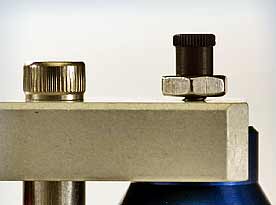 In the photos you see a clear top on the combo Airnoids. This is a dual purpose thing that keeps dirt out of the workings and allows you to monitor plunger wear, if any. More on plunger wear later. In the photos you see a clear top on the combo Airnoids. This is a dual purpose thing that keeps dirt out of the workings and allows you to monitor plunger wear, if any. More on plunger wear later.
This photo shows the T bar and a space between it and the lock nut. This is similar to your valve to rocker arm lash and is set at .020. The .020 ensures that the plunger is seated properly. If the plunger wears in the lash will decrease and you simply reset the clearance and race on.
Pressure capacity
The nitrous Airnoids are rated at 1250 psi maximum so naturally I tried them at 1350 psi.
They opened and closed repeatedly with no drama. Granted, there is no sound reason to be at 1250 psi since the nitrous is in a supercritical phase beyond 1060 psi but the Airnoids can handle it as advertised.
The fuel Airnoids are rated at a maximum of 90 psi which is way beyond any system requirements that I have worked on, seen or heard of so life is good and they can be used with low or high pressure fuel systems including EFI. Naturally I ran them at 100 psi. No problems whatsoever, thus proving that they are correctly rated.
Flow Capacity
Flow capacity is pretty impressive. The nitrous side far exceeds what we normally use via the electrical solenoids and the fuel side meets and exceeds what it was intended to replace.
Results
Nitrous Results were obtained at 900 lbs w bottle topped off each test. Fuel Results were obtained @ 8lbs of pressure with .740 specific gravity test fluid.
Nitrous: |
Fuel: |
| Common .116 Bo |
1620 Lbs/Hr |
Common .157 solenoid |
559 Lbs/Hr |
| CF 400 Silver |
2630 Lbs/Hr |
FS-500 single Red Airnoid |
596 Lbs/Hr |
| CR 450 Gold |
2970 Lbs/Hr |
CF-400 Silver Combo |
602 Lbs/Hr |
| NS500 Blue |
4750 Lbs/Hr |
CF-450 Gold Combo |
789 Lbs/Hr |
| |
|
NS-500 single Blue |
1127 Lbs/Hr |
Progressive use
At the moment the Airnoids will not function with a progressive controller. In the previous article on the Racing Instrumentation PROgressive box I used a rotating door analogy to show what the flow is doing during the pulse phase. The flow and corresponding pressure never actually falls back to zero. The same thing happens here with the co2. While the little electric Actuator handles the pulsing just fine, the actual flow of co2 does not have enough time to dump to the atmosphere allowing the plunger return spring to do its job. The system will pulse 1 to 1 ½ times before it goes into a float mode so there is not enough pulsing spikes for our purposes. There may be some hope. A couple of ideas are being tested to allow the pulsing to be utilized. Stay tuned.
Observations
On the high end of things all the Airnoids can improve the fill time of any system and do a better job of packing the lines. You may be able to tell that I prefer that the jets to be the final restriction and not the solenoid. In some cases where rules dictate a single solenoid there is a lack of capacity to fill the jet sizes available. Double bar plates come to mind. Any of the Airnoids can improve this situation substantially. The highest flowing electric nitrous solenoid I currently use has a .250 orifice and flows 4117 lbs/hr. This is way overkill for most applications but the FS500 blue single does it one better which now makes it the baddest valve on the planet, hands down.
The story is similar with the fuel. My best Nitrous Master .250 orifice fuel solenoid flows 982 lbs/hr and using the FS500 Airnoid as a fuel valve would be even better and it has a smaller orifice and lighter weight.
|
